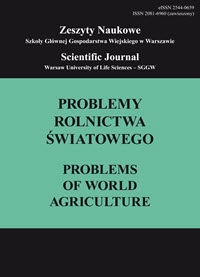Main Article Content
Article Details
Basch, G., González-Sánchez, E.J., Gil-Ribes, J., Ordóñez-Fernández, R.,Veroz-González, O., Triviño-Tarradas, P., Carbonell-Bojollo, R., Márquez-García, F., Gómez-Ariza, M., Holgado-Cabrera, A., Moreno-García, M. (2017). Mitigation of climate change through conservation agriculture in Europe. World Congress 7 on Conservation Agriculture. Rosary, Argentina, 1-4 August 2017, 67-71.
Bayer, C., Gomes, J., Vieira, F.C.B, Zanatta, J.A., Piccolo, M.C., Dieckow, J. (2012). Methane emission from soil under long-term no-till cropping systems. Soil and Tillage Research, 124, 1-7. (Crossref)
Bieńkowski, J., Jankowiak, J. (2006). Zawartość węgla organicznego w glebie i jego zmiany pod wpływem różnych systemów produkcji. (Organic carbon content in soils and its changes under the influence of different production systems). Fragmenta Agronomica, 2(90), 216-225.
Dignac, M.F., Derrien, D., Barré, P., Barot, S., Cécillon, L., Chenu, C., Chevallier, T., Freschet, G.T., Garnier, P., Guenet, B., Hedde, M., Klumpp, K., Lashermes, G., Maron, P.A., Nunan, N., Roumet, C., Basile-Doelsch, I. (2017). Increasing soil carbon storage: mechanisms, effects of agricultural practices and proxies. A review. Agronomy for Sustainable Development, 37, 14. DOI:10.1007/s13593-017-0421-2. (Crossref)
ECCP (European Climate Change Programme). (2003). Working Group Sinks Related to Agricultural Soils Final Report. Pobrano 4 kwietnia 2018 z: https://ec.europa.eu/clima/sites/clima/files/eccp/second/docs/finalreport_ agricsoils_en.pdf.
Faber, A., Jarosz, Z. (2018). Modelowanie bilansu azotu oraz emisji podtlenku azotu i amoniaku w skali regionalnej oraz Polsce. (Modeling of nitrogen balance and emission of nitrous oxide and ammonia on a regional scale and in Poland). ZN SGGW Problemy Rolnictwa Światowego, 18(2), 70-81. (Crossref)
Faber, A., Jarosz, Z., Łopatka, A., Siebielec, G. (2015). Ocena zmian zawartości węgla organicznego w glebach na podstawie danych monitoringu chemizmu gleb ornych w Polsce. (Assessment of changes in organic carbon content in soils based on monitoring data on arable soil chemistry in Poland). Studia i Raporty IUNG-PIB, 46(20), 9-20.
Freibauer, A., Rounsevell, M. D. A., Smith, P., Verhagen, J. (2004). Carbon sequestration in the agricultural soils of Europe. Geoderma, 122, 1–23. (Crossref)
Giltrap, D. L., Li, C., Saggar, S. (2010). DNDC: A process-based model of greenhouse gas fluxes from agricultural soil. Agriculture, Ecosystems and Environment, 136, 292-300. (Crossref)
Gu, J., Yuan, M., Liu, J., Hao, Y., Zhou, Y., Qu, D., Yang, X. (2017). Trade-off between soil organic carbon sequestration and nitrous oxide emissions from winter wheat-summer maize rotations: Implications of a 25-year fertilization experiment in Northwestern China. Science of the Total Environment, 595, 371–379. (Crossref)
IPCC (2007). IPCC Fourth Assessment Report: Climate Change 2007. Contribution of Working Group I to the Fourth Assessment Report of the Intergovernmental Panel on Climate Change, 2007. 2.10.2 Direct Global Warming Potentials. Pobrano 11 kwietnia 2018 z: https://www.ipcc.ch/publications_and_data/ar4/ wg1/en/ch2s2-10-2.html#table-2-14.
Jaskulska, I., Jaskulski, D., Kotwica, K., Wasilewski, P., Gałęzewski, L. (2013). Effect of tillage simplifications on yield and grain quality of winter wheat after different previous crops. Acta Scientarum Polonorum Agricultura, 12(3), 37-44.
Kane, D. (2015). Carbon sequestration potential on agricultural lands: a review of current science and available practices. Breakthrough and strategies solution. National Sustainable Agriculture Coalition. pp. 35. Pobrano 5 kwietnia 2018 z: https://pdfs.semanticscholar.org/b89f/31b2d289b5b55f4a71cd3eeca55b38123a9e.pdf
Kertész, Á., Madarász, B. (2014). Conservation agriculture in Europe. International Soil and Water Conservation Research, 1, 91-96. (Crossref)
Komisja Europejska (2016). Rozporządzenie Parlamentu Europejskiego i Rady w sprawie rocznych wiążących ograniczeń emisji gazów cieplarnianych przez państwa członkowskie w latach 2021-2030 na rzecz stabilnej unii energetycznej i w celu wywiązania się ze zobowiązań wynikających z porozumienia paryskiego, oraz zmieniające rozporządzenie Parlamentu Europejskiego i Rady nr 525/2013 w sprawie mechanizmu monitorowania i sprawozdawczości w zakresie emisji gazów cieplarnianych oraz zgłaszania innych informacji mających znaczenie dla zmian klimatu (Regulation of the European Parliamentand of the Council on binding annual greenhouse gas emission reductions by Member States from 2021 to 2030 for a resilient Energy Union and to meet commitments under the Paris Agreement and amending Regulation No 525/2013 of the European Parliament and the Council on a mechanism for monitoring and reporting greenhouse gas emissions and other information relevant to climate change). COM(2016) 482 wersja ostateczna.
Krasuska, E., Faber, A., Jarosz, Z., Kaczyński, R. (2016). Modelling soil organic carbon sequestration under crops for biofuels in Poland. Polish Journal of Agronomy, 27, 126-136.
Krawczynski, R., Milne, E., Banwart, S. (2015). Soil carbon, multiple benefits. Journal of Environmental Research and Development, 13, 33-38.
Leip, A., Marchi, G., Koeble, R., Kempen, M., Britz, W., Li, C. (2008). Linking an economic model for European agriculture with a mechanistic model to estimate nitrogen and carbon losses from arable soils in Europe. Biogeoscience, 5, 73-94. (Crossref)
Le Mer, J., Roger, P. (2001). Production, oxidation, emission and consumption of methane by soils: A review. European Journal of Soil Biology, 37, 25−50. (Crossref)
Lugato, E., Leip, A., Jones, A. (2018). Mitigation potential of soil carbon management overestimated by neglecting N2O emissions. Nature Climate Change, 8, 219-223. (Crossref)
Lugato, E., Bampa, F., Panagos, P., Montanarella, L., Jones, A. (2015). Potential carbon sequestration of European arable soils estimated by modelling a comprehensive set of management practices. Global Change Biology, 20, 3557-3567. (Crossref)
Merante, P., Dibari, C., Ferrise, R., Bindi, M., Lesschen, P.J., Kuikman, P., Sanchez, B., Iglesias, A. (2014). Report on critical low soil organic matter contents, which jeopardise good functioning of farming systems. Smart Soil Project. Sustainable farm Management Aimed at Reducing Threats to Soils under climate change. Deliverable 2.4. Pobrano 4 marca 2018 z: http://smartsoil.eu/fileadmin/www.smartsoil.eu/Deliverables/ D2_4_SmartSoil_Final.pdf.
Peltre, C., Christensen, B.T., Dragon, S., Icard, C., Kätterer, T., Houot, S. (2012). RothC simulation of carbon accumulation in soil after repeated application of widely different organic amendments. Soil Biology and Biochemistry, 52, 49–60. (Crossref)
Pittelkow, C.M., Linquist, B.A., Lundy, M.E., Liang, X., van Groenigen, K.J., Lee, J., van Gestel, N., Six, J., Rodney, T. Venterea, R.T., van Kessel, C. (2015). When does no-till yield more? A global meta-analysis. Field Crop Research, 183, 156-168. (Crossref)
Poeplau, C., Kätterer T., Bolinder M.A., Gunnar Börjesson G., Berti A., Lugato E. (2015). Low stabilization of aboveground crop residue carbon in sandy soils of Swedish long-term experiments. Geoderma, 237-238, 246-255. (Crossref)
Ranaivoson, L., Naudin, K., Ripoche, A., Affholder, F., Rabeharisoa, L., Corbeels, M. (2017). Agro-ecological functions of crop residues under conservation agriculture. A review. Agronomy for Sustainable Development, 37, 26. (Crossref)
Searle, S., Bitnere, K. (2017). Review of the impact of crop residue management on soil organic carbon in Europe. The International Council on Clean Transportation, Working Paper 2017-15. Pobrano 4 kwietnia 2018 z: https://www.theicct.org/sites/default/files/publications/EU-crop-residue-mgmt_ICCT-working-paper_15122017_vF.pdf.
Smith, P., Martino, D., Cai, Z., Gwary, D., Janzen, H.H., Kumar, P., McCarl, B., Ogle, S., O’Mara, F., Rice, C., Scholes, R.J., Sirotenko, O., Howden, M., McAllister, T., Pan, G., Romanenkov, V., Schneider, U., Towprayoon, S., Wattenbach, M., Smith, J.U. (2008). Greenhouse gas mitigation in agriculture. Philosophical Transactions of the Royal Society B, 363, 789-813. (Crossref)
Soane, B.D., Ball, B.C., Arvidsson, J. Basch, G., Moreno, F., Roger-Estrade, J. (2013). No-till in northern, western and southwestern Europe: a review of problems and opportunities for crop production and the environment. Soil and Tillage Research, 118, 66-87. (Crossref)
Stockmann, U., Adams, M.A., Crawford, J.W., Field, D.J., Henakaarchchi, N., Jenkins, M., Minasny, B., McBratney, A.B., de Remy de Courcelles, V., Singh, K., Wheeler, I., Abbott, L., Angers, D.A., Baldock, J., Bird, M., Brookes, P.C., Chenu, C., Jastrow, J.D., Lal, R., Lehmann, J., O’Donnell, A.G., Parton, W.J., Whitehead, D., Zimmermann, M. (2013). The knowns, known unknowns and unknowns of sequestration of soil organic Carbon. Agriculture, Ecosystems and Environment, 164, 80-99. (Crossref)
Stuczyński, T., Kozyra, J., Łopatka, A., Siebielec, G., Jadczyszyn, J., Koza, P., Doroszewski, A., Wawer, R., Nowocień, E. (2007). Przyrodnicze uwarunkowania produkcji rolniczej w Polsce. (Natural conditions of agricultural production in Poland). Studia i Raporty IUNG-PIB, 7, 1-39.
West, T.O., Six, J. (2007). Considering the influence of sequestration duration and carbon saturation on estimates of soil carbon capacity. Climatic Change, 80, 25-41. DOI: 10.1007/s10584-006-9173-8. (Crossref)
Wiśniewski, P., Kistowski, M. (2017). Agriculture and rural areas in the local planning of low carbon economy in light of the idea of sustainable development – results from a case study in north-central Poland. Fresenius Environmental Bulletin, 26(8), 4927-4935.
Van den Putte, A., Govers, G., Diels, J., Gillijns, K., Demuzere, M. (2010). Assessing the effect of soil tillage on crop growth: A meta-regression analysis on European crop yields under conservation agriculture. European Journal of Agronomy, 33, 231-241. (Crossref)
Verschuuren, J. (2018). Towards an EU regulatory framework for climate-smart agriculture: the example of soil carbon sequestration. Transnational Environmental Law, 7(2), 301-322. DOI: 10.1017/S2047102517000395. (Crossref)
Downloads
- Zuzanna Jarosz, Potencjał energetyczny biomasy roślinnej i możliwości wykorzystania do celów energetycznych , Zeszyty Naukowe SGGW w Warszawie - Problemy Rolnictwa Światowego: Tom 17 Nr 2 (2017)
- Antoni Faber, Zuzanna Jarosz, Charakterystyka zrównoważenia rozwoju biogospodarki w Polsce - wymiar ekologiczny , Zeszyty Naukowe SGGW w Warszawie - Problemy Rolnictwa Światowego: Tom 23 Nr 1 (2023)
- Antoni Faber, Zuzanna Jarosz, Zmiany i możliwości rozwoju biogospodarki w Polsce na tle Unii Europejskiej , Zeszyty Naukowe SGGW w Warszawie - Problemy Rolnictwa Światowego: Tom 23 Nr 3 (2023)
- Antoni Faber, Zuzanna Jarosz, Tomasz Żyłowski, Weryfikacja możliwości redukcji emisji amoniaku dla różnych praktyk aplikacji gnojowicy w Polsce , Zeszyty Naukowe SGGW w Warszawie - Problemy Rolnictwa Światowego: Tom 19 Nr 2 (2019)
- Antoni Faber, Zuzanna Jarosz, Aleksandra Król, Wpływ zmian klimatu na efektywność wykorzystywania azotu oraz jego straty , Zeszyty Naukowe SGGW w Warszawie - Problemy Rolnictwa Światowego: Tom 19 Nr 1 (2019)
- Antoni Faber, Zuzanna Jarosz, Modelowanie emisji podtlenku azotu i amoniaku w skali regionalnej oraz w Polsce , Zeszyty Naukowe SGGW w Warszawie - Problemy Rolnictwa Światowego: Tom 18 Nr 2 (2018)
- Antoni Faber, Zuzanna Jarosz, Charakterystyka zrównoważenia rozwoju biogospodarki w wymiarze ekonomicznym w Polsce na tle UE-28 i Niemiec , Zeszyty Naukowe SGGW w Warszawie - Problemy Rolnictwa Światowego: Tom 23 Nr 2 (2023)

Utwór dostępny jest na licencji Creative Commons Uznanie autorstwa – Użycie niekomercyjne 4.0 Międzynarodowe.





